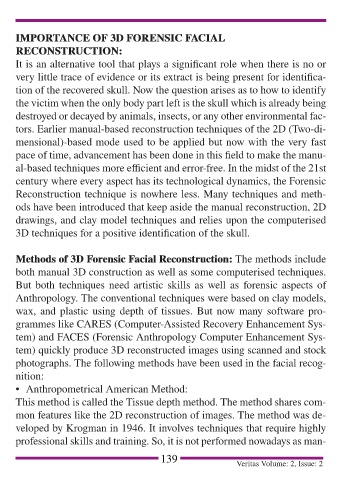Page 148 - VERITAS Vol.2 Issue 2
P. 148
IMPORTANCE OF 3D FORENSIC FACIAL
IMP OR T AN CE OF 3D F OR ENSIC F A CI AL
RECONSTRUCTION:
R E C ONS T R UC T ION:
It is an alternative tool that plays a significant role when there is no or
very little trace of evidence or its extract is being present for identifica-
tion of the recovered skull. Now the question arises as to how to identify
the victim when the only body part left is the skull which is already being
destroyed or decayed by animals, insects, or any other environmental fac-
tors. Earlier manual-based reconstruction techniques of the 2D (Two-di-
mensional)-based mode used to be applied but now with the very fast
pace of time, advancement has been done in this field to make the manu-
al-based techniques more efficient and error-free. In the midst of the 21st
century where every aspect has its technological dynamics, the Forensic
Reconstruction technique is nowhere less. Many techniques and meth-
ods have been introduced that keep aside the manual reconstruction, 2D
drawings, and clay model techniques and relies upon the computerised
3D techniques for a positive identification of the skull.
Methods of 3D Forensic Facial Reconstruction: The methods include
Me thods of 3D F or ensic F acial R ec ons t r uc t ion:
both manual 3D construction as well as some computerised techniques.
But both techniques need artistic skills as well as forensic aspects of
Anthropology. The conventional techniques were based on clay models,
wax, and plastic using depth of tissues. But now many software pro-
grammes like CARES (Computer-Assisted Recovery Enhancement Sys-
tem) and FACES (Forensic Anthropology Computer Enhancement Sys-
tem) quickly produce 3D reconstructed images using scanned and stock
photographs. The following methods have been used in the facial recog-
nition:
• Anthropometrical American Method:
This method is called the Tissue depth method. The method shares com-
mon features like the 2D reconstruction of images. The method was de-
veloped by Krogman in 1946. It involves techniques that require highly
professional skills and training. So, it is not performed nowadays as man-
139 Veritas Volume: 2, Issue: 2

